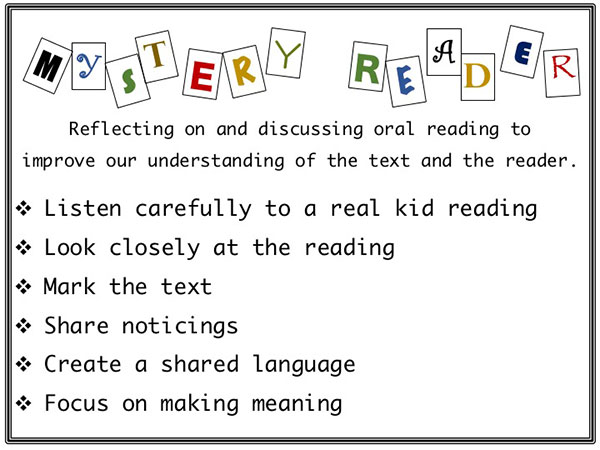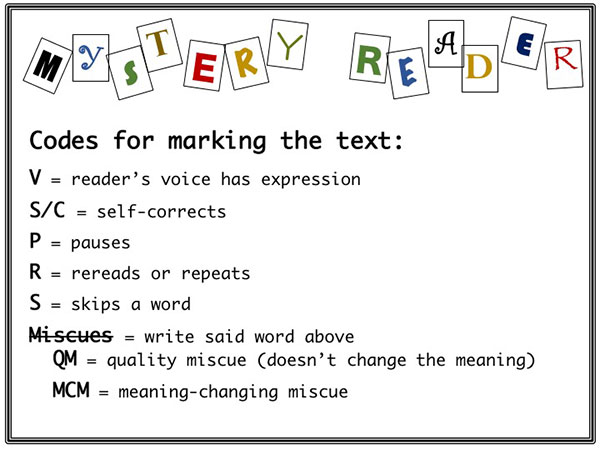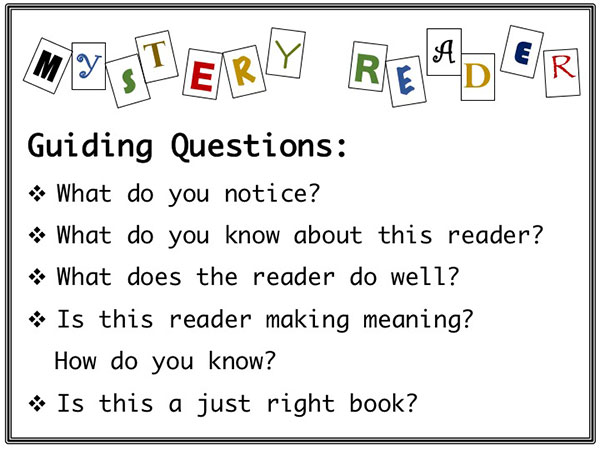In this column, I’m pleased to share a brief overview of “Nurturing the Development of Reflective Readers,” a session I attended at “Echoes of Learning,” the literacy conference at Zaharis Elementary in Mesa, AZ. Kris-Ann Florence and Megan Kypke, second and fourth grade teachers, shared how they promote reflection and enhance comprehension by using a student version of miscue analysis to help readers understand the importance of meaning-making. In kid-friendly language, it’s simply called “Mystery Reader.” Kris-Ann and Megan showcased the power of this engaging and fun approach to literacy learning by demonstrating it in action. They were assisted by an eager bunch of brave students who volunteered to spend part of their Saturday showing what they know in front of a group of conference attendees. The activity is usually introduced and shared with the whole class. However, it could certainly be done with small groups of students who need extra guidance and support with decoding, fluency, self-monitoring, comprehension, or choosing good-fit books.
Teaching kids how to effectively participate in meaningful discussion about what it means to be a reader is the ultimate goal of “Mystery Reader.” You might agree that being respectful and sensitive about correcting errors and offering suggestions for improvement requires a degree of tact and finesse that may not be refined in most seven- to eleven-year-olds. To counter this, Kris-Ann and Megan stressed the importance of sharing audio recordings of oral reading that guarantee to keep the identity of the reader a mystery. They rely on an inventory of recordings of anonymous students from years gone by as well as excerpts collected from audio swapping with teacher friends from other schools or districts.
I was so captivated by this unique idea! And as much as I love working as an instructional coach, the thought of setting up this “Mystery Reader” as a routine literacy practice made me really wish I had my own classroom again. I’m hopeful that next fall I can support teachers who are interested with this innovative approach to fostering independent, confident, and motivated readers.

The steps to implementing “Mystery Reader” are simple. I’ve outlined them as if I were presenting them to students.
First, set the purpose.
In this activity we will listen to someone we don’t know read a short passage as we follow along with a copy of the text. We will learn how to take notes about the reading so that we can talk about what we noticed and give advice to the reader. “Mystery Reader” helps us understand the text and the reader. It helps us become better readers because we also learn about how each of us reads on our own.

Second, explain and practice marking the text with students.
- When we read aloud it is important to read with expression, to sound the way the character would really sound. We’ll call that using “voice.” Any time a mystery reader does a great job of using voice, we will write a “V” on the paper at that spot.
- When a reader fixes a mistake all by him or herself, we’ll call that a “self-correct” and will write down an “S/C.”
- Sometimes readers pause because they are stuck on a word or are thinking about the text. Other times readers will repeat or reread a word or sentence to make it sound better. If either of these happen, we will write down a “P” or an “R.”
- If the reader skips a word, we will write down an “S.”
- Finally, we will listen and watch carefully for any words that are not said correctly. These are called “miscues.” If that happens, we will cross out the word and we will write the word the reader said instead above the one we just crossed out.
- Later when we talk about the miscues, we will decide if the word the reader said changed the meaning or not. If the meaning was not changed, for example saying “home” instead of “house,” we will write “QM” for “quality miscue.” But if the meaning did change because of the miscue, we will write “MCM” for “meaning changing miscue.”

Third, practice, reflect on, and discuss the process using guiding questions.
This year we will be practicing, thinking about, and talking about “Mystery Readers.” We will share things we notice about what makes each reader a good reader. We will really focus on whether the reader is making meaning or understanding the text and we will decide if the text was a “good fit.”
And finally, students demonstrate greater awareness and comprehension in their own reading.
As we get more comfortable doing “Mystery Reader,” we will see how it helps us with our own reading. We will be able to use voice to show good expression when we read aloud. We will also get better at self-correcting our miscues. And if we do have miscues when we read, we will be able to figure out if they are quality miscues or meaning-changing miscues. All of these things will be important ways to help us learn how to choose “good fit books” and gain meaning from the texts we read.
A final note about “Mystery Reader”… For as long as I can remember, I have strived to capitalize on time spent with students in one-on-one sessions involving reading conferences or taking running records. When classrooms are filled with 25 – 30 students who range significantly in their reading proficiency, self-monitoring ability, motivation, and self-confidence, it is imperative that teachers bring efficiency and a sense of urgency and fun to the table. “Mystery Readers” has the potential to do all of these things in one sweet and simple swoop.
The next Teach it Forward column will offer additional ideas for implementing “Mystery Reader.” Suggestions for collecting oral reading samples and adding a comprehension conference portion to the activity will be offered.
RESOURCES
The origins of this approach date back to 1996 with “Retrospective Miscue Analysis” by Yetta Goodman. To learn more, check out these articles and handouts:
“Retrospective Miscue Analysis: Revaluing Readers and Reading” by Yetta Goodman and Ann Marek
“Retrospective Miscue Analysis: An Effective Intervention for Students in Grades 3 – 12,” presented by Sue Haertel
